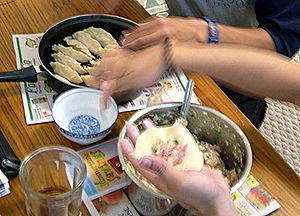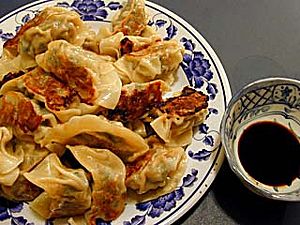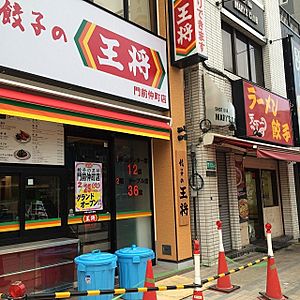Jiaozi facts for kids

A plate of boiled jiaozi with dipping sauce
|
|
| Type | Dumpling |
|---|---|
| Course | Normally as an entree |
| Place of origin | China |
| Region or state | East Asia |
| Serving temperature | Hot |
| Main ingredients | Dough, ground meat or vegetables |
| Jiaozi | |||||||||||||||||||
|---|---|---|---|---|---|---|---|---|---|---|---|---|---|---|---|---|---|---|---|

"Jiaozi" in Traditional (top) and Simplified (bottom) Chinese characters
|
|||||||||||||||||||
| Chinese name | |||||||||||||||||||
| Traditional Chinese | 餃子 | ||||||||||||||||||
| Simplified Chinese | 饺子 | ||||||||||||||||||
|
|||||||||||||||||||
| Manchu name | |||||||||||||||||||
| Manchu script | ᡤᡳᠶᠣᠰᡝ | ||||||||||||||||||
| Möllendorff | giyose | ||||||||||||||||||
Jiaozi (Chinese: 餃子;) are a Chinese dumpling commonly eaten in China and other parts of East Asia. They are one of the major dishes eaten during the Chinese New Year and year-round in the northern provinces. Though considered part of Chinese cuisine, jiaozi are popular in other parts of East Asia and in the Western world, where a fried variety is sometimes called potstickers. The English-language term "pot sticker" is a literal translation from Chinese word Guotie. It was used by Buwei Yang Chao and her husband Yuen Ren Chao in the book How to Cook and Eat in Chinese, which was first published in 1945.
Jiaozi typically consist of a ground meat and/or vegetable filling wrapped into a thinly rolled piece of dough, which is then sealed by pressing the edges together. Finished jiaozi can be boiled (shuǐ jiǎo), steamed (zhēng jiǎo) or pan-fried (jiān jiǎo) and are traditionally served with a black vinegar and sesame oil dip. They can also be served with soup.
Contents
Origin and custom
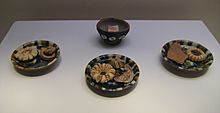
In China, there are several different folk stories explaining the origin of jiaozi and its name.
Traditionally, jiaozi were thought to be invented during the era of the Eastern Han (AD 25–220) by Zhang Zhongjing who was a great practitioner of traditional Chinese medicine. Jiaozi were originally referred to as "tender ears" (Chinese: 嬌耳; pinyin: jiao'er) because they were used to treat frostbitten ears. Zhang Zhongjing was on his way home during wintertime, when he found many common people had frostbitten ears, because they did not have warm clothes and sufficient food. He treated these poor people by stewing lamb, black pepper, and some warming medicines in a pot, chopped them, and used them to fill small dough wrappers. He boiled these dumplings and gave them with the broth to his patients, until the coming of the Chinese New Year. In order to celebrate the New Year as well as recovering from frostbitten ears, people imitated Zhang's recipe to make Jiao'er.
Other theories suggest that jiaozi may have derived from dumplings in Western Asia. In the Western Han dynasty (206 BC – AD 9) jiaozi (餃子) were called jiaozi (角子). During the Three Kingdoms period (AD 220–280), the book Guangya by Zhang Yi mentions jiaozi. Yan Zhitui during the Northern Qi dynasty (AD 550–577) wrote: "Today the jiaozi, shaped like a crescent moon, is a common food in the world." Six Dynasties Turfan tombs contained dumplings. Later in the Tang dynasty (AD 618–907), jiaozi become more popular, called Bian Shi (扁食). Chinese archaeologists have found a bowl of jiaozi in the Tang dynasty tombs in Turpan. 7th or 8th century dumplings and wontons were found in Turfan.
Jiaozi may also be named because they are horn-shaped. The Chinese word for "horn" is jiao (Chinese: 角; pinyin: jiǎo), and jiaozi was originally written with the Chinese character for "horn", but later it was replaced by the specific character 餃, which has the food radical on the left and the phonetic component jiāo (交) on the right.
At the same time, jiaozi look like yuan bao silver or gold ingots used as currency during the Ming dynasty, and as the name sounds like the word for the earliest paper money, serving them is believed to bring prosperity. Many families eat these at midnight on Chinese New Year's Eve. Some cooks will even hide a clean coin inside a jiaozi for the lucky to find.
Nowadays, jiaozi are eaten year-round, and can be eaten for breakfast, lunch or dinner. They can be served as an appetizer, a side dish, or as the main course. In China, sometimes jiaozi is served as a last course during restaurant meals. As a breakfast dish, jiaozi are prepared alongside xiaolongbao at inexpensive roadside restaurants. Typically, they are served in small steamers containing ten pieces each. Although mainly serving jiaozi to breakfast customers, these small restaurants keep them hot on steamers and ready to eat all day. Jiaozi are always served with a dipping sauce that may include vinegar, soy sauce, garlic, ginger, rice wine, hot sauce, and sesame oil. They can also be served with soup.
Types
Chinese dumplings (jiaozi) may be divided into various types depending on how they are cooked:
- Boiled dumplings (simplified Chinese: 水饺; traditional Chinese: 水餃; pinyin: shuǐjiǎo; literally "water dumpling")
- Steamed dumplings (simplified Chinese: 蒸饺; traditional Chinese: 蒸餃; pinyin: zhēngjiǎo; literally "steam dumpling")
- Pan-fried dumplings (simplified Chinese: 煎饺; traditional Chinese: 煎餃; pinyin: jiānjiǎo; literally "dry-fried dumplings"), and (simplified Chinese: 锅贴; traditional Chinese: 鍋貼; pinyin: guōtiē; literally "pan stick") also referred to as "pot-stickers"
- Soup dumplings (simplified Chinese: 汤饺; traditional Chinese: 湯餃; pinyin: tāngjiǎo; literally "soup dumpling")
Dumplings that use egg rather than dough to wrap the filling are called "egg dumplings" (simplified Chinese: 蛋饺; traditional Chinese: 蛋餃; pinyin: dànjiǎo; literally "egg dumpling").
Fillings
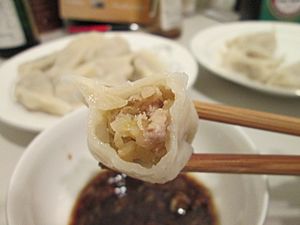
As a dish prepared at home, each family has its own preferred method of making them, using favorite fillings, with types and methods of preparation varying widely from region to region. Common dumpling meat fillings include pork, mutton, beef, chicken, fish, and shrimp, which are usually mixed with chopped vegetables. Popular vegetable fillings include napa cabbage, scallion (spring onions), leek, celery, spinach, mushroom, edible black fungus, carrot, and garlic chives.
Folding technique
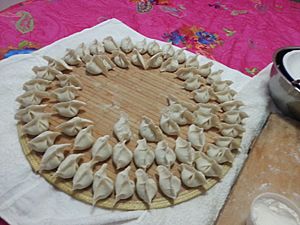
There are many ways to fold jiaozi. Basically, steps for folding the skin includes putting a single pleat in the middle, putting multiple pleats along the edge, making a wavy edge like a pie crust, turning a pleated edge in toward the body resulting in a rounded edge, and putting both ends together resulting in a round shape. Different shapes of Jiaozi require different folding techniques, but the most famous and common technique is the pinched-edge fold. Take a wrapper and put one tablespoon of filling into the center of the wrapper. Fold a half of edge to the other half. Use left thumb and forefinger to pinch one side of the half-moon wrapper, and then use right thumb to push the inside skin outward, right forefinger to make outside skin into small pleats. Use right thumb to clench those pleats. Repeat these steps to the other side of the wrapper, and make sure to clench the seal of Jiaozi. This is crescent-shaped jiaozi, the most popular shape in China.
Variations
Guangdong
Jiaozi is called gaau ji in Cantonese and are standard fare in Guangdong style dim sum. The immediate noted difference to Northern style is that they are smaller and wrapped in a thinner translucent skin, and usually steamed. The smaller size and the thinner wrapper make the dumplings easier to cook through with steaming. In contrast to jiaozi, Guangdong gaau ji are rarely home-made because the wrapper, which needs to be thin but tough enough to not break, is more difficult to make. Many types of fillings exist, with the most common type being har gow (simplified Chinese: 虾饺; traditional Chinese: 蝦餃; Cantonese Yale: hā gáau; literally "shrimp dumplings"), but fillings can include scallop, chicken, tofu, and mixed vegetables; dim sum restaurants often feature their own house specials or innovations. Dim sum chefs and artists often use ingredients in new or creative ways, or draw inspiration from other Chinese culinary traditions, such as Chaozhou, Hakka, or Shanghai. More creative chefs may even create fusion gaau ji by using elements from other cultures, such as Japanese (teriyaki) or Southeast Asian (satay or curry), while upscale restaurants may use expensive or exotic ingredients such as lobster, shark fin and bird's nest.
Another Cantonese dumpling is yau gok (Chinese: 油角; pinyin: yóu jiǎo; Cantonese Yale: yàuh gok), which are made with glutinous rice dough and deep fried.
Guotie
Guotie (Chinese: 鍋貼; pinyin: guōtiē; literally "pot stick") also known as potstickers (a direct character translation), or yaki-gyōza (焼き餃子, lit. “pan-fried jiaozi”) in Japan. They are a Northern Chinese style dumpling popular as a street food, appetizer, or side order in Chinese cuisine. Guotie differs from pan fried dumplings, or Jianjiao, in that the shape of Guotie is usually elongated and the two ends are often left open. Also Guotie is pan fried directly, and only fried on the bottom side, whereas Jianjiao is fried after it is fully cooked and usually fried on all sides. Guotie is sometimes served on a dim sum menu, but may be offered independently. The filling for both Guotie and Jianjiao usually contains pork (sometimes chicken, or beef in Muslim areas), cabbage (or Chinese cabbage and sometimes spinach), scallions (spring or green onions), ginger, Chinese rice wine or cooking wine, and sesame seed oil.
Guotie or Potstickers are shallow-fried in a wok (Chinese: 镬; pinyin: huò). A small quantity of water is added and the wok is covered. While the base of the dumplings is fried, the upper part is steamed and this gives a texture contrast typical of Chinese cuisine.
Jianjiao or pan fried dumplings is steamed in a wok and then fry to crispness on one or many side in a shallow frying pan.
Exactly the same dumpling is boiled in plenty of water to make jiaozi and both are eaten with a dipping sauce or chilli paste.
Three or five folds are made on one side of the round wrapper that is rolled so that the edges are thinner than the middle. This gives the base a large surface area that helps to give the dumpling stability to stand up in the pan.
One Chinese method of preparing the dough is to pour boiling water onto the flour and letting stand for five minutes and then adding a small quantity of cold water. This helps to activate the gluten in the dough.
Other names for guotie:
- Peking ravioli – In Boston, guotie are known as "Peking ravioli", a name first coined at the Joyce Chen Restaurant in Cambridge, Massachusetts, in 1958.
- Wor tip (Cantonese Jyutping: wo1 tip3) is the Cantonese reading of the same Chinese characters that in Mandarin is read as guōtiē'
History
Guōtiē is said to date back over four millennia. However, the first mention in literature dates back to the medieval Chinese Song Dynasty (AD 960 – 1280) reporting guōtiē as being exceptionally good for the human soul. Legend has it that they were invented by an imperial Chinese court chef who panicked after realizing he'd accidentally burnt a batch of dumplings. With no time to make any more, he eventually served them to the Emperor. 7th or 8th century old dumplings and wontons were found in Turfan.
Gyōza
The Japanese word gyōza (ギョーザ, ギョウザ) was derived from the reading of 餃子 in the Jilu Mandarin (giǎoze) and is written using the same Chinese characters. The use of katakana script indicates that the word is of non-Japanese origin. Following the Second World War, Japanese soldiers who returned from northeastern China brought home gyōza recipes.
The prevalent differences between Japanese-style gyōza and Chinese-style jiaozi are the rich garlic flavor, which is less noticeable in the Chinese version, and that gyōza wrappers appear to be consistently thinner, due to the fact that most Japanese restaurants use machine-made wrappers. In contrast, the rustic cuisine of poor Chinese immigrants shaped westerners' views that Chinese restaurant jiaozi use thicker handmade wrappers. As jiaozi vary greatly across regions within China, these differences are not clear. For example, visitors will easily find thin skinned ones at restaurants in Shanghai, and from street food vendors in the Hangzhou region. Gyōza are identical to jiaozi made in Chinese households using store bought machine made wrappers. Gyōza are usually served with soy-based tare sauce seasoned with rice vinegar and/or chili oil (rāyu in Japanese, làyóu (辣油) in Mandarin Chinese). The most common recipe is a mixture of minced pork (sometimes chicken or beef), cabbage, Asian chives, and sesame oil, and/or garlic, and/or ginger, which is then wrapped into thinly rolled dough skins. Gyoza share similarities with both pierogi and spring rolls and are cooked in the same fashion as pierogi, either boiled or fried.
Gyōza and gyōza wrappers can be found in supermarkets and restaurants throughout Japan, either frozen or ready to eat. Pan-fried gyōza are sold as a side dish in many ramen and Chinese restaurants.
The most popular preparation method is the pan-fried style called yaki-gyōza (焼き餃子), in which the dumpling is first fried on one flat side, creating a crispy skin. Then, water is added and the pan sealed with a lid, until the upper part of the dumpling is steamed. This technique is what the Chinese call guotie or potstickers (see above). Other popular methods include boiling sui-gyōza (水餃子) and deep frying age-gyōza (揚げ餃子).
Store-bought frozen dumplings are often prepared at home by first placing them in a pot of water, bringing it to a boil, and then transferring them to a pan with oil to fry the skin.
History
Momo
The Tibetan version is known as momo (Tibetan: མོག་མོག་) The word "momo" comes from a Chinese loanword, "momo" (饃饃), which translates to "steamed bread". When preparing momo, flour is filled, most commonly with ground water buffalo meat. Often, ground lamb or chicken meat is used as alternate to water buffalo meat. Finely chopped onion, minced garlic, fresh minced ginger, cumin powder, salt, coriander/cilantro, etc. are added to meat for flavoring. Sauce made from cooked tomatoes flavored with timur (Sichuan pepper), minced red chilies is often served along with momo.
Jiaozi and wonton
Jiaozi should not be confused with wonton. Jiaozi have a thicker skin and a relatively flatter, more oblate, double-saucer like shape, and are usually eaten with a soy-vinegar dipping sauce (and/or hot chili sauce), while wontons have thinner skin and are usually served in broth. The dough for the jiaozi and wonton wrappers also consist of different ingredients.
See also
 In Spanish: Jiaozi para niños
In Spanish: Jiaozi para niños







